It wasn’t the cleanest performance, but a sparkling performance from Ian Book and timely stops by the Notre Dame defense prevented Boston College from posing a real threat. While the Eagles surprisingly created seven scoring chances, they settled for early field goals while the Irish offense piled up touchdowns early (when not fumbling for dramatic effect).
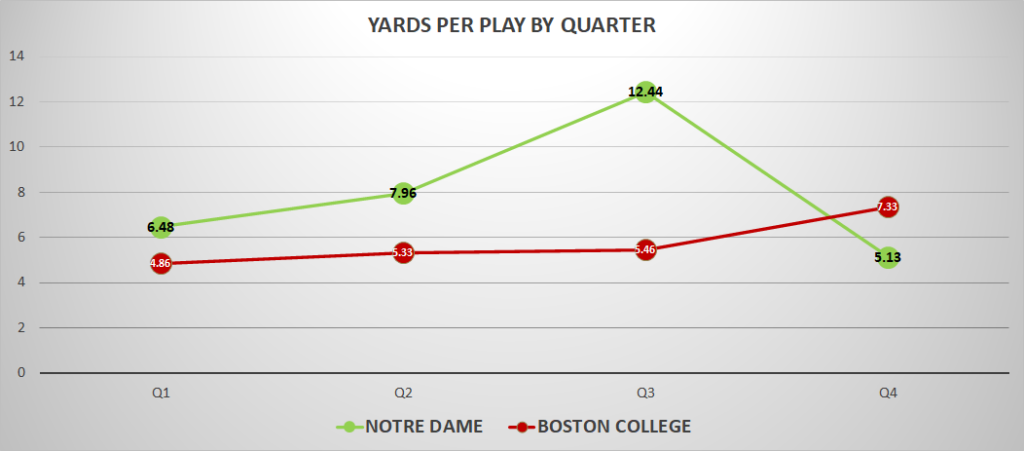
No garbage time counted in this game, although the late Eagles drives came primarily against the Irish second-string defense. By point margin this game went in and out of garbage time in the 4th, but Ian Book never departed, and when it’s a toss up it’s good to err on the side of counting more plays. But keep in mind the Irish clearly took their foot off the gas pedal, with 20 runs on 23 plays in the final period, and only five passes in the second half.
Explosiveness
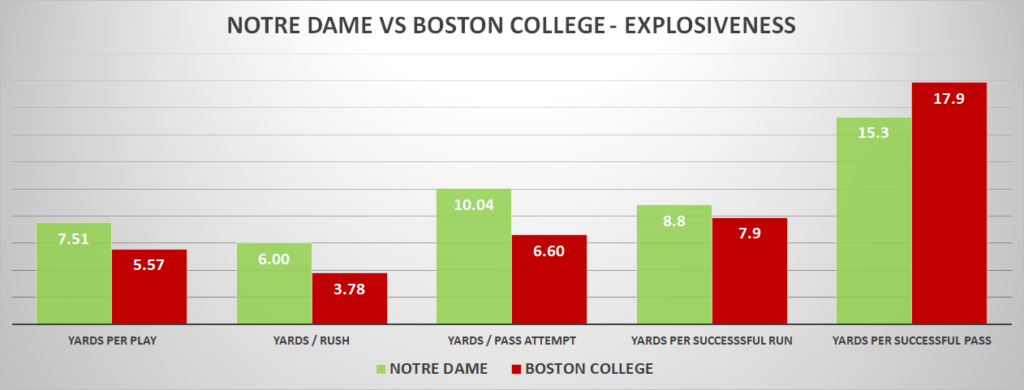
Ian Book followed up the best game of his career with arguably his best statistical performance (not taking into account opponent quality). The captain was over 10 yards per attempt (including sacks) for just the second time in his career against a P5 opponent, the other occasion coming against Northwestern in 2018. The Tommy Rees – Book connection feels almost telepathic at this point, and Book moved comfortably in the pocket, took shots downfield, and appeared in complete command throughout the game. Along with his outstanding work through the air, Ian also chipped in 85 yards on the ground on only ten attempts.
It’s still a little early to proclaim this as the final evolution of Book following the Clemson win, but it wouldn’t be a surprise if that performance vaulted his confidence to a new level. The developing connection with Ben Skowronek (10.3 yards per target against BC) makes the ND passing game even more difficult to defend – while the losses of Kevin Austin and Braden Lenzy hurt, defenses can’t as confidently predict where Book is looking to go with the ball. The versatility of the Irish tight ends adds to the challenge, as Tremble and Mayer can shift from devastating blockers to threats split out wide in an instant. When all four of Mayer, Tremble, McKinley and Skowronek are on the field there’s a ton of big targets to defend.
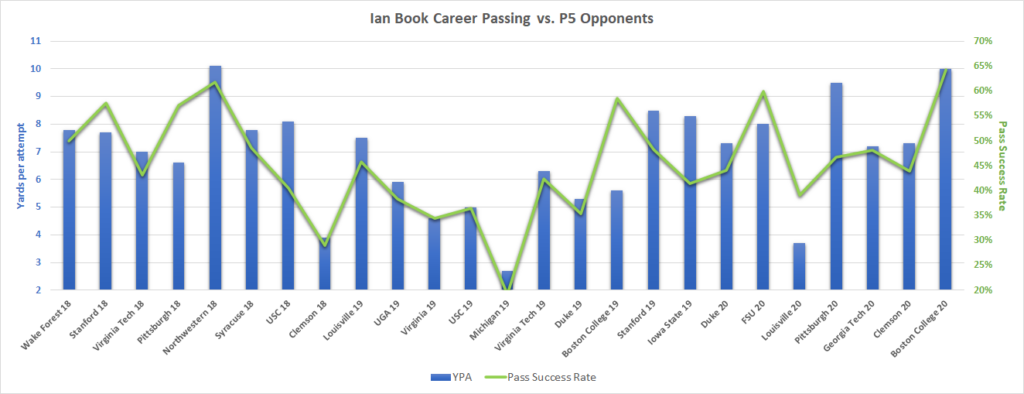
Looking back at the course of Ian’s career as a starter (and taking out G5 opponents to reduce some crazy but not that impressive peaks) tells an interesting story. You see the immaculate start after taking over for Brandon Wimbush, albeit against a combination of mediocre and bad defenses. The start of 2019 brought challenging defenses and a major drop in both efficiency and explosiveness, with the bottom falling out in the rain in Ann Arbor. Beginning with the closing stretch of last season and into this fall though, there’s been consistently great play with only the exception of the windy game against Louisville.
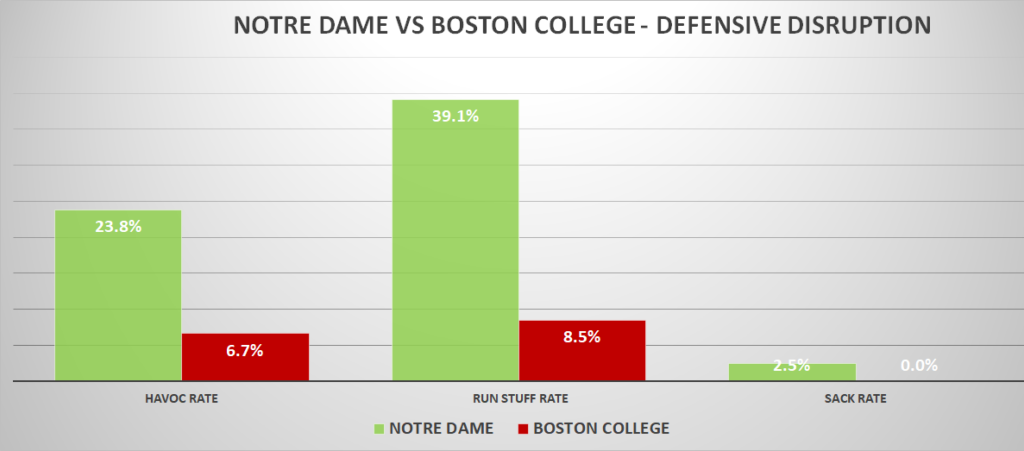
Clark Lea seems like a very kind human being that happens to be a very mean defensive coordinator. While this wasn’t the finest performance by the Irish defense – seven red zone trips allowed exceeded Clemson’s total – Phil Jurkovec had to work for every conversion. Lea mostly took away his favorite players – explosive WR Zay Flowers had just two successful plays and three catches on 12 targets, and TE Hunter Long had just one catch until late in the 3rd quarter.
Even when Jurkovec was able to connect on some deep balls downfield, it felt like he was just dodging disaster with sacks and near-interceptions. Notre Dame continues to generate havoc as well as any team in the country, and impressively it’s balanced between the front seven and secondary.
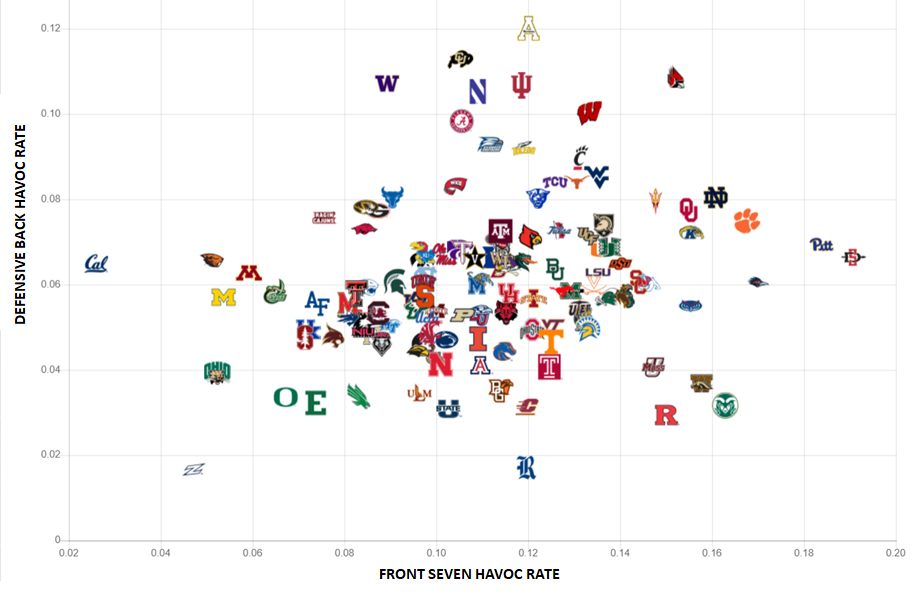
It’s less noticeable but just as critical that the Irish offense has been terrific avoiding negative plays – with a minuscule run stuff rate in this game, the average Notre Dame 3rd down had just 4.8 yards to convert. When you lead the nation in stuff rate and are top-10 level in preventing stuffs on offense, a big efficiency advantage will follow.
Efficiency
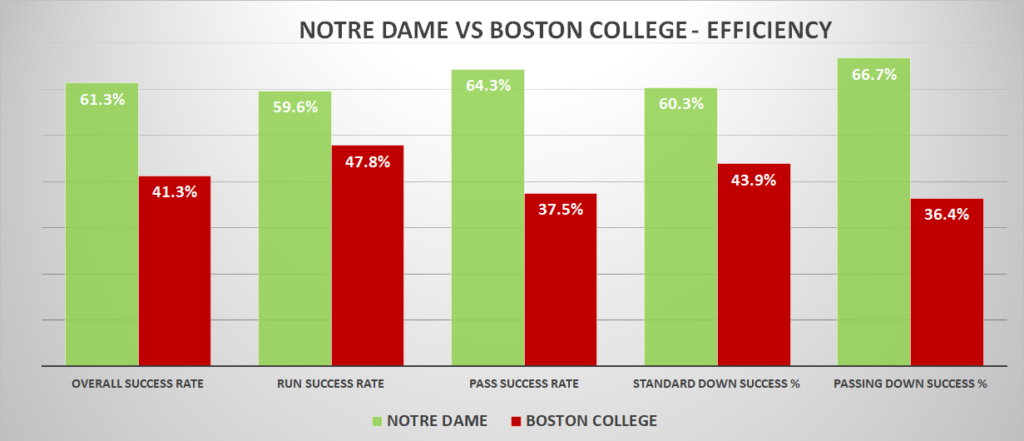
The efficiency battle was a well-rounded beating despite the Irish defense giving up one of their higher success rates of the year (still just about the national average of 41%). Notre Dame was effective in every phase of the game, while the Eagles scraped by to keep drives alive. BC’s run success rate seems excellent, but was the result of many short conversions and masks that with so many negative runs they gained just 3.8 yards per carry.
If there’s anything to be concerned about, particularly heading into a weekend with a dangerous Carolina passing attack, it’s the secondary in one on one situations. It feels like the Irish are a little more vulnerable against the deep ball than in past years, and a mediocre rank in explosive passing plays allowed – an area where Clark Lea historically has had defenses in the top 5 – is a bit unsettling. But the passing success rate allowed is borderline elite, there aren’t coverage busts, and in 2020 just about everyone is getting hit with some shots through the air. Alabama allowed Ole Miss to go for 13 yards per pass a few weeks ago and Indiana was over the 10 yard mark against Ohio State this past weekend – I’m not sure if there just aren’t great pass defenses this year or if good passing offenses on the right day are mostly unstoppable with the current state of the game.
Finishing Drives, Field Position, & Turnovers
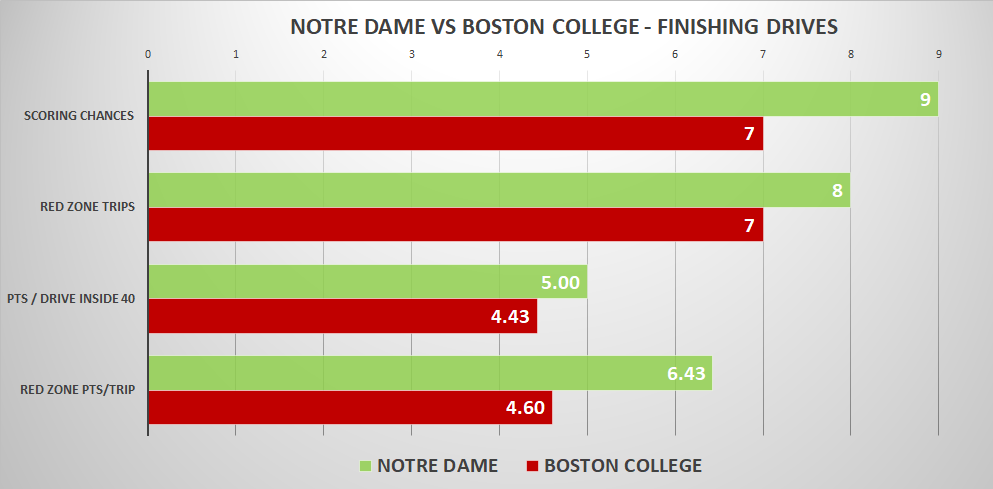
The Irish were excellent in the red zone for the vast majority of this game, reeling off scores after the first drive of the game stalled out with a field goal. Fumbling issues gifted some terrific field position and instant scoring chances for BC, but the Irish defense held strong. The Eagles averaged just three yards per scoring opportunity until late in the second half, eventually scoring 15 points on their final two red zone trips.
Speaking of field position, average starting drives position was a draw (each at their own 35), with each team starting with a few very favorable possessions. The Irish ended every drive with a touchdown, field goal attempt, or fumble, and fortunately had replay review save another shaky attempt at an onside kick recovery.

Notre Dame ballcarriers have now lost more fumbles (7) in eight games than in 13 games a season ago. Some bad luck is partially responsible, as the Irish have now lost 70% when you’d expect 50/50, but they’ve also put it on the turf more often (1.25 fumbles per game versus 0.77 / game in ’19 and ’18). Jurkovec was lucky to walk away with only one interception after putting several balls in danger including several directed toward Kyle Hamilton.
On to Carolina
The final challenge of the regular season is almost here, as the Irish travel on Black Friday (already weird vibes) to Chapel Hill to face a North Carolina team that should probably be undefeated. Sam Howell and the Tar Heel offense have an argument for the best offense in the conference, with a passing game rivaling Clemson but far more success in 2020 on the ground.
While the Irish have the advantage in both trenches, it’s a scary matchup in that if both offenses are clicking, it will likely become a tennis match where it comes down to which defense can break serve more often. The Notre Dame defense and Clark Lea should be that answer, but it will be fascinating to see how he approaches a well-rounded team with several dynamic wide receivers. The USC game a season ago saw Lea daring a dangerous passing attack to run the ball or go to its second and third receivers, and that worked long enough in the first half to hold on for a win.
The pressure will be on Ian Book’s shoulders again, now without two starting linemen, to take advantage of a mediocre Tar Heel defense. UNC has one of the poorer run defenses in the conference, allowing opponents a 47% run success ate, but ultimately it’s incumbent on Book and Rees to ensure drives end in touchdowns instead of kicks and avoid turnovers that can swing the game.

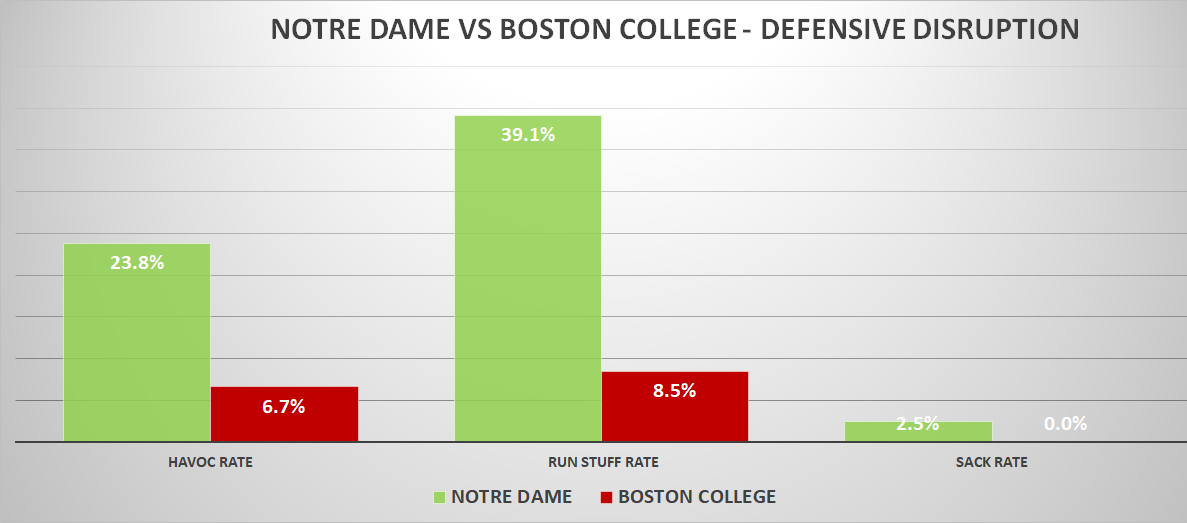
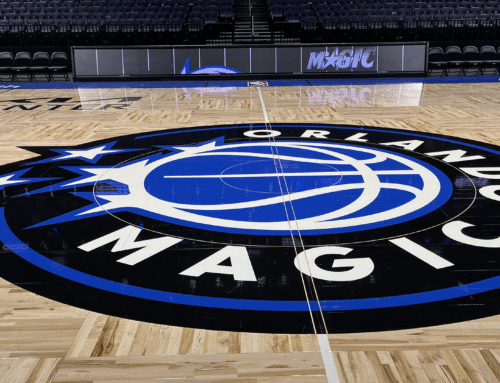
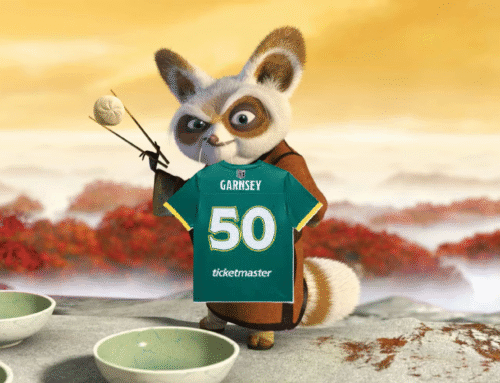
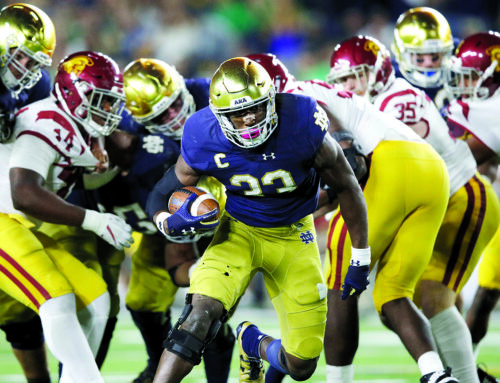
Consider me squarely in the camp as concerned about Carolina this weekend. Their advanced stats are much better than their ranking and they are being punished in the polls for a dumb loss and having played more games.
I think when you combine the performance of the D the last two weeks with all the playmakers Carolina has, Nd could be in some trouble. The one positive is their offense will give Nd a taste of Clemson game 2 and any potential playoff games
I think Clark Lea has decided to sell out for Havoc plays a bit this year over his historical soft coverage, bend-but-don’t-break scheme from past years. Which is a good thing, in my opinion. Bend but don’t break is good against average offenses; most college football players just aren’t good enough to consistently put together 10 play scoring drives. But the elite teams are, and elite teams can pick apart soft coverage. By going for more Havoc plays, you’re setting yourself up to potentially give up some big plays to lesser teams, but give yourself a chance to make massive plays against great teams. When you’re trying to play for a National Championship, this is exactly how you should be playing.
I’m not sure schematically it’s been all that different so much as it’s been an adaptation to personnel. The front four is good but maybe on a downtick in terms of getting pressure without bringing extra guys without Kareem + Okwara (although Ogundeji I think has equaled Kareem last season). The secondary has a couple more weak points versus ’18 where Love + Pride were so good as a tandem and safety was very shored up and ’19 where you felt really good about Elliott + Gilman + Kyle often being deployed all together.
If you look at where the havoc boost is coming from, a good chunk is run defense – sacks per game is about even versus last year, but TFL in the run game is up by 1.5ish a game and leading the nation in run stuff rate is a massive improvement. Pass break-ups per game are also up. Last year a big part of the bend but dont break was a crazy high turnover rate, which was awesome but not sustainable.
Long way of saying I don’t disagree that being more aggressive is a good approach with this group, but I’m not sure it’s been a choice by Lea so much as how things have played out with this group’s strengths and weaknesses.
Interesting. I’d love to see what percentage of snaps they’re blitzing on this year vs. last year. To me, it feels like we’ve been blitzing more than any year since Van Gorder was around.
Great analysis! I think that UNC can be dangerous, but I trust that the Irish should be okay barring a string of bad turnovers — the bye week rest should help the defense which looked a little tired / sloppy at times recently. I agree that this will be a good prep for the Clemson rematch.
Counterpoint: UNC is a bc onside kick and wake forest not squandering a 21pt second half lead from having 4 losses. 2 losses seems about right for them.
Still that potent offense is a worry and we always play bizarre games against the heels. I like the Irish off a bye and still feeling the disrespect being a meager 4 point favorite.
Yeah, this game is giving me a bit of Iowa State vibes. Last year, everybody was saying how good they were, and how they just had a few bad breaks that cost them an incredible record. Meanwhile, everybody was ignoring that they caught a bunch of breaks that led to them even being above .500 (like beating an FCS team in OT).
I think UNC has 1 strength on offense and no strengths on defense. I trust Clark Lea to be able to contain UNCs strength, and I think a double digit victory is in order.